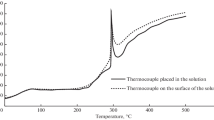Abstract
When zirconium oxides are formed via hydrolytic condensation of zirconium alkoxides, the particle size and morphology of the resultant zirconia is strongly affected by certain parameters during the condensation. These parameters include: the type of alkyl group in the alkoxide, water/alkoxide ratio, molecular separation of species, and the reaction temperature. The particle size and the morphology in turn affect the sintering behaviour and crystalline transformation of ZrO2, In this work the parameters that affect the formation of ZrO2 from zirconium alkoxides are investigated. It has been shown that the alkyl groups and molecular separations during the hydrolytic polycondensation have particular significance in the modification of monoclinic → tetragonal transformation of the resultant ZrO2. Tetragonal phase can also be stabilized by copolymerization of ZrO2 with SiO2 producing tough ceramic materials.
Similar content being viewed by others
References
D. C. Bradley, R. C. Mehrota andD. P. Gaur, “Metal Alkoxides” (Academic Press, New York, 1978) p. 30.
D. C. Bradley andW. Wardlaw,J. Chem. Soc. 73 (1951) 280.
D. C. Bradley, in “Metal-Organic Compounds” Advances in Chemistry, Series 23 (American Chemical Society, Washington, DC, 1959) pp. 10–36.
K. S. Mazdiyasni, C. T. Lynch andJ. S. Smith,J. Amer. Ceram. Soc. 48 (7) (1965) 372.
Idem, ibid. 50(10) (1967) 532.
B. E. Yoldas,ibid. 65(8) (1982) 387.
D. C. Bradley andD. G. Carter,Can. J. Chem. 39 (1961) 1434.
Idem, ibid. 40 (1962) 15.
B. E. Yoldas,J. Non-Cryst. Solids 51 (1982) 105.
Idem,ibid. in press.
Idem, ibid. 63 (1984) 145.
Idem, Material Research Society Symposium Proceedings (Elsevier Science, New York, 1984) Vol. 24, p. 291.
E. A. Barringer, N. Jubb, B. Fegley, R. L. Pober andH. K. Brown, in “Ultrastructure Processing of Ceramics, Glasses, and Composites” edited by L. Hench and D. Ulrich (Wiley, New York, 1984) pp. 315–333.
T. K. Gupta,Sci. Sinter. 10 (1978) 205.
K. S. Mazdiyasni, in “Reactivity of Solids” Proceedings of the VI International Symposium on the Reactivity of Solids, Schenectady, January, 1969, edited by J. W. Mitchell (Wiley-Interscience, New York) pp. 115–25.
E. C. Sabbarao, H. S. Maiti andK. K. Srivastava,Phys. Status Solidi 21 (1974) 9.
T. K. Gupta, F. F. Lange andJ. H. Bechtold,J. Mater. Sci. 13 (1978) 1464.
F. F. Lange,J. Mater. Sci. 17 (1982) 225.
D. L. Porter andA. H. Heuer,J. Amer. Ceram. Soc. 62 (1979) 295.
D. C. Bradley,Nature 182 (1958) 1211.
D. C. Bradley, R. C. Mehrota, J. D. Swanwick andW. Wardlaw,J. Chem. Soc. 73 (1953) 2025.
W. Wardlaw,ibid. (1956) 4004.
E. C. Sabbarao, H. S. Maiti andK. K. Srivastava,Phys. Status Solidi A21 (1974) 9.
G. K. Bansal andA. H. Heuer,Acta Metall. 20(11) (1972) 1281.
R. C. Garvie, R. H. Hannink andR. T. Pascoe,Nature 258 (1975) 703.
D. L. Porter andA. H. Heuer,J. Amer. Ceram. Soc. 60(6-3) (1977) 183.
T. Mitsuhashi, M. Ichihara andU. Tatsuke,J. Amer. Ceram. Soc. 57 (2) (1974) 97.
H. Knapp andV. Dehlinger,Acta Metall. 4 (1956) 289.
G. B. Olson andM. Cohen,Met. Trans. 7A (1976) 1897.
B. E. Yoldas,J. Mater. Sci. 4 (1979) 1843.
Author information
Authors and Affiliations
Rights and permissions
About this article
Cite this article
Yoldas, B.E. Zirconium oxides formed by hydrolytic condensation of alkoxides and parameters that affect their morphology. J Mater Sci 21, 1080–1086 (1986). https://doi.org/10.1007/BF01117398
Received:
Accepted:
Issue Date:
DOI: https://doi.org/10.1007/BF01117398




